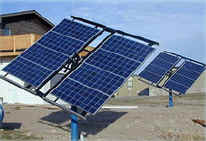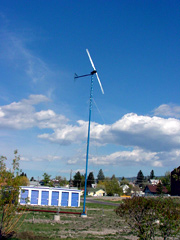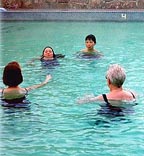Solar Power
Solar, Wind, Geothermal
Power
on Display at Spa Hot Springs�
 As
much as he can, Gene Gudmundson takes advantage of� solar, wind and geothermal
energy�at Spa
Hot Springs Motel in White Sulphur Springs. As
much as he can, Gene Gudmundson takes advantage of� solar, wind and geothermal
energy�at Spa
Hot Springs Motel in White Sulphur Springs.
"We utilize all alternative
energy sources available to us," Gudmundson says. "We believe in thinking
globally and acting locally. We use our natural resources to provide your comfort,
but we do it in a way that is not harmful to the environment. We strive to be
a model of clean energy consumption and better business for the future."
That philosophy led Gudmundson
to install a wind turbine and solar electric panels last December to meet some
of his electricity needs.
 The
Whisper 175 wind turbine sits atop a 44-foot tower. The 3000-watt rated turbine
delivers in excess of 500 kilowatt hours per month in a 12 mph wind. The Southwest
Windpower machine has a 14-foot rotor diameter and features a handmade fiberglass
and foam core blade for smooth, high-efficiency operation and low-wind start-up.
It also incorporates a patented "angle governor" design for quiet operation
in high winds. It has a peak power rating of 3200 watts at 27 mph. The
Whisper 175 wind turbine sits atop a 44-foot tower. The 3000-watt rated turbine
delivers in excess of 500 kilowatt hours per month in a 12 mph wind. The Southwest
Windpower machine has a 14-foot rotor diameter and features a handmade fiberglass
and foam core blade for smooth, high-efficiency operation and low-wind start-up.
It also incorporates a patented "angle governor" design for quiet operation
in high winds. It has a peak power rating of 3200 watts at 27 mph.
According to Gudmundson, "the
only sound you'll hear is when the wind is really pounding on it � and then only
if you stand next to it."
The tower and turbine, installed
by Sunelco of Hamilton,
Montana, stand 100 feet or so from the spa and motel.
"You can hear it sometimes
at night, but it's not an unpleasant sound," says Gudmundson "The only
comments we've had from motel guests have all been positive."
Gudmundson�s 16-panel solar electric
system, also installed in December by Sunelco, includes two Kyocera 120-watt solar
modules that produce 7.1 amps at 16.9 volts. Both arrays are mounted on Zomeworks
racks that track the sun.
"It is kind of neat to watch
the thing move and follow the sun," Gudmundson says.
The wind and solar systems are
net metered, which allows them to feed excess electricity back into the utility
grid. The two systems provide about a quarter of the Spa�s electric power needs.�
"We�ve got a very large electric
load," Gudmundson says. The load includes lighting and appliances for a 21-room
motel, pools and dressing rooms and Gudmundson�s Hot Springs Natural Health Clinic
and chiropractic office, which serves clients from all over.
At current rates of 6-7 cents
a kilowatt hour, electric bills for the facility run between $600-$1,000 per month.
 A
bank of 12 batteries provides a backup system if the Spa loses power, which would
be more than a mere inconvenience. If the power fails, and the pump stops working
in the well, water builds up and flows onto the ground. A
bank of 12 batteries provides a backup system if the Spa loses power, which would
be more than a mere inconvenience. If the power fails, and the pump stops working
in the well, water builds up and flows onto the ground.
"Muddy water will flow back
and foul our well," explains Gudmundson. "Now with a backup system,
if the power goes � whether for a half hour or two hours � the battery system
will circumvent that whole problem."
While the Spa uses the sun and
wind to help generate electricity, it relies on hot water from geothermal wells
to provide heat � and, of course, to replenish the Spa�s pools, which are known
worldwide for their ideal mineral content and soothing properties. The chemistry
of the waters has frequently been praised and often compared to Baden-Baden, the
famous spa in Germany.
 "We
like to say that the waters of Baden-Baden are almost, but not quite, as good
as these," says Gudmundson. "We
like to say that the waters of Baden-Baden are almost, but not quite, as good
as these," says Gudmundson.
Water flows from the ground at
the Spa at 130 degrees. Gudmundson uses a system of heat exchangers to heat the
rooms and domestic water. The system delivers water to the pool at 120 degrees.
With wind and solar added in, Gudmundson
estimates that the Spa produces more than half of its energy using renewable resources.
"We're certainly one of a
kind when we combine geothermal, solar and wind in a commercial facility like
this," he says. "I'm certain nobody else does that, at least not to
this degree."
To help finance the system, Gudmundson
received a grant from the universal system benefits fund administered by Montana
Power Company and paid for by all the utility�s customers. The grant covered about
a quarter of the total project cost of $40,000.
Despite a few glitches and delays
in getting the system running, Gudmundson says he�s pleased with the results.
"The pool ties in with the
clinic, which ties in with the alternative energy stuff," he says. "It's
all natural, healthy and non-polluting. They all tie in. They all complement one
another."
Gudmundson says he�s often asked
why he chose to produce his own power since he�s already drawing electricity from
the utility at a relatively inexpensive rate.
 "Is
it economical? Do you mean within the first year or two? No," he says. "But
I think it is economical in the long term because it is going to save electricity
here this year, next year and the year after that." And, he adds, "Personally
I like the aesthetics of it." "Is
it economical? Do you mean within the first year or two? No," he says. "But
I think it is economical in the long term because it is going to save electricity
here this year, next year and the year after that." And, he adds, "Personally
I like the aesthetics of it."
He likes the looks and other benefits
so well, in fact, that he�s already making plans to install additional solar panels
and possibly another wind turbine.
"Our goal is
to be completely self-sufficient with solar, wind and geothermal," he says.
"And obviously as electricity prices go up, the payback becomes less."
|